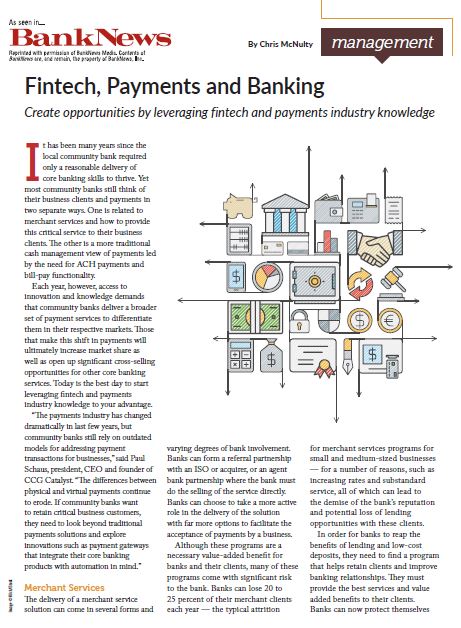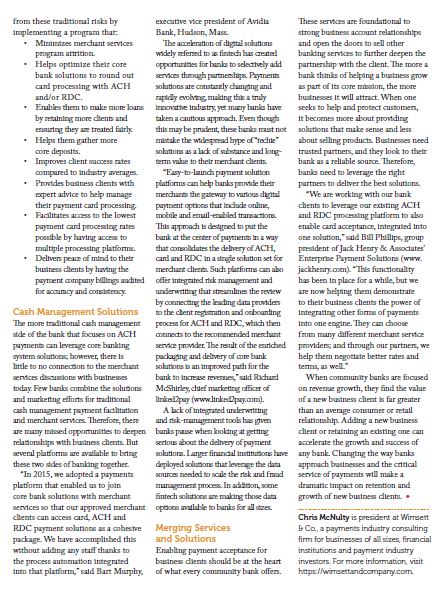Fintech, Payments and Banking
It has been many years since the local community bank required only a reasonable delivery of core banking skills to thrive. Yet most community banks still think of their business clients and payments in two separate ways. One is related to merchant services and how to provide this critical service to their business clients. The other is a more traditional cash management view of payments led by the need for ACH payments and bill-pay functionality. Each year, however, access to innovation and knowledge demands that community banks deliver a broader set of payment services to differentiate them in their respective markets. Those that make this shift in payments will ultimately increase market share as well as open up significant cross-selling opportunities for other core banking services. Today is the best day to start leveraging fintech and payments industry knowledge to your advantage. “The payments industry has changed dramatically in last few years, but community banks still rely on outdated models for addressing payment transactions for businesses,” said Paul Schaus, president, CEO and founder of CCG Catalyst. “The differences between physical and virtual payments continue to erode. If community banks want to retain critical business customers, they need to look beyond traditional payments solutions and explore innovations such as payment gateways that integrate their core banking products with automation in mind.”
Merchant Services
The delivery of a merchant service solution can come in several forms and varying degrees of bank involvement. Banks can form a referral partnership with an ISO or acquirer, or an agent bank partnership where the bank must do the selling of the service directly. Banks can choose to take a more active role in the delivery of the solution with far more options to facilitate the acceptance of payments by a business. Although these programs are a necessary value-added benefit for banks and their clients, many of these programs come with significant risk to the bank. Banks can lose 20 to 25 percent of their merchant clients each year — the typical attrition for merchant services programs for small and medium-sized businesses— for a number of reasons, such as increasing rates and substandard service, all of which can lead to the demise of the bank’s reputation and potential loss of lending opportunities with these clients. In order for banks to reap the benefits of lending and low-cost deposits, they need to find a program that helps retain clients and improve banking relationships. They must provide the best services and value added benefits to their clients.
Banks can now protect themselves from these traditional risks by implementing a program that:
• Minimizes merchant services program attrition.
• Helps optimize their core bank solutions to round out card processing with ACH and/or RDC.
• Enables them to make more loans by retaining more clients and ensuring they are treated fairly.
• Helps them gather more core deposits.
• Improves client success rates compared to industry averages.
• Provides business clients with expert advice to help manage their payment card processing.
• Facilitates access to the lowest payment card processing rates possible by having access to multiple processing platforms.
• Delivers peace of mind to their business clients by having the payment company billings audited for accuracy and consistency.
Cash Management Solutions
The more traditional cash management side of the bank that focuses on ACH payments can leverage core banking system solutions; however, there is little to no connection to the merchant services discussions with businesses today. Few banks combine the solutions and marketing eff orts for traditional cash management payment facilitation and merchant services. Therefore, there are many missed opportunities to deepen relationships with business clients. But several platforms are available to bring these two sides of banking together. “In 2015, we adopted a payments platform that enabled us to join core bank solutions with merchant services so that our approved merchant clients can access card, ACH and RDC payment solutions as a cohesive package. We have accomplished this without adding any staff thanks to the process automation integrated into that platform,” said Bart Murphy, executive vice president of Avidia Bank, Hudson, Mass. The acceleration of digital solutions widely referred to as fintech has created opportunities for banks to selectively add services through partnerships. Payments solutions are constantly changing and rapidly evolving, making this a truly innovative industry, yet many banks have taken a cautious approach. Even though this may be prudent, these banks must not mistake the widespread hype of “techie” solutions as a lack of substance and longterm value to their merchant clients. “Easy-to-launch payment solution platforms can help banks provide their merchants the gateway to various digital payment options that include online, mobile and email-enabled transactions. This approach is designed to put the bank at the center of payments in a way that consolidates the delivery of ACH, card and RDC in a single solution set for merchant clients. Such platforms can also offer integrated risk management and underwriting that streamlines the review by connecting the leading data providers to the client registration and onboarding process for ACH and RDC, which then connects to the recommended merchant service provider. Th e result of the enriched packaging and delivery of core bank solutions is an improved path for the bank to increase revenues,” said Richard McShirley, chief marketing officer of linked2pay (www.linked2pay.com). A lack of integrated underwriting and risk-management tools has given banks pause when looking at getting serious about the delivery of payment solutions. Larger financial institutions have deployed solutions that leverage the data sources needed to scale the risk and fraud management process. In addition, some fintech solutions are making those data options available to banks for all sizes.
Merging Services and Solutions
Enabling payment acceptance for business clients should be at the heart of what every community bank offers. These services are foundational to strong business account relationships and open the doors to sell other banking services to further deepen the partnership with the client. The more a bank thinks of helping a business grow as part of its core mission, the more businesses it will attract. When one seeks to help and protect customers, it becomes more about providing solutions that make sense and less about selling products. Businesses need trusted partners, and they look to their bank as a reliable source. Therefore, banks need to leverage the right partners to deliver the best solutions. “We are working with our bank clients to leverage our existing ACH and RDC processing platform to also enable card acceptance, integrated into one solution,” said Bill Phillips, group president of Jack Henry & Associates’ Enterprise Payment Solutions (www.jackhenry.com). “This functionality has been in place for a while, but we are now helping them demonstrate to their business clients the power of integrating other forms of payments into one engine. They can choose from many diff erent merchant service providers; and through our partners, we help them negotiate better rates and terms, as well.” When community banks are focused on revenue growth, they find the value of a new business client is far greater than an average consumer or retail relationship. Adding a new business client or retaining an existing one can accelerate the growth and success of any bank. Changing the way banks approach businesses and the critical service of payments will make a dramatic impact on retention and growth of new business clients.


